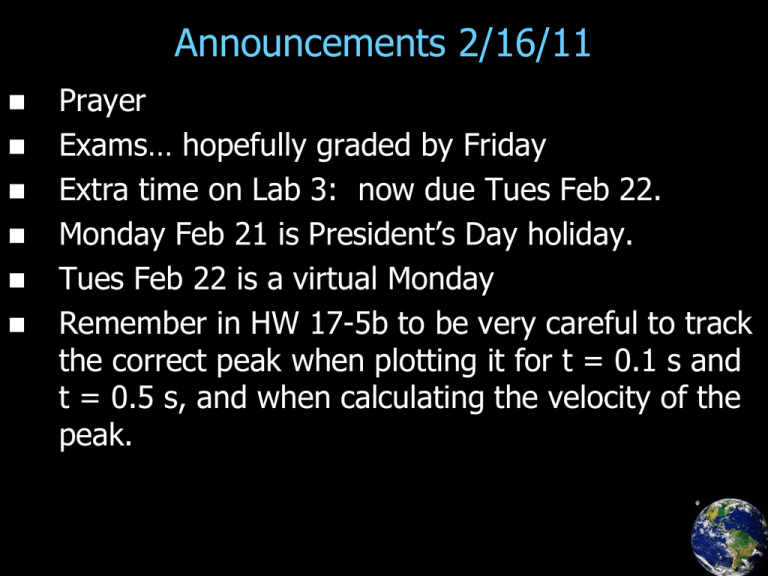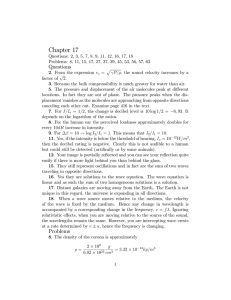Lecture 18 - sound waves
advertisement

Announcements 2/16/11 Prayer Exams… hopefully graded by Friday Extra time on Lab 3: now due Tues Feb 22. Monday Feb 21 is President’s Day holiday. Tues Feb 22 is a virtual Monday Remember in HW 17-5b to be very careful to track the correct peak when plotting it for t = 0.1 s and t = 0.5 s, and when calculating the velocity of the peak. Thought question A wave at frequency ω traveling from a string to a rope. At the junction, 80% of the power is reflected. How much power would be reflected if the wave was going from the rope to the string instead? a. Much less than 80% b. A little less than 80% c. About 80% d. More than 80% e. It depends on the color of the rope. AR v2 v1 r AI v1 v2 AT 2v2 t AI v1 v2 R r2 T 1 R Demo Reflection at a boundary Dispersion Summary A dispersive medium: velocity is different for different frequencies Any wave that isn’t 100% sinusoidal contains multiple frequencies. To localize a wave in space or time, you need lots of frequencies… really an infinite number of frequencies spaced infinitely closely together. Two Different Velocities What happens if a wave pulse is sent through a dispersive medium? Nondispersive? Dispersive wave example: a. s(x,t) = cos(x-4t) + cos(2 (x-5t)) – What is “v”? – What is v for w=4? What is v for w=10? What does that wave look like as time progresses? (next slide) Mathematica 0.1 seconds 0.7 seconds 1.3 seconds Time Evolution of Dispersive Pulse Credit: Dr. Durfee Power spectrum Peak moves at about 13 m/s (on my office computer) Wave moving in time Note: frequencies are infinitely close together How much energy is contained in each frequency component Phase and Group Velocity Credit: Dr. Durfee Window is moving along with the peak of the pulse vp w k velocity of "wiggles" Can be different for each frequency component that makes up the wave 12.5 m/s, for dominant component dw vg dk velocity of "envelope" evaluatedat kave 13 m/s (peak) A property of the wave as a whole On Wikipedia Example where vphase > vgroup http://en.wikipedia.org/wiki/Group_velocity Not yet on Wikipedia Example where vphase is negative! Reading Quiz Sound waves are typically fastest in: a. solids b. liquids c. gases Sound Waves What type of wave? What is waving? Demo: Sound in a vacuum Demo: tuning fork Demo: Singing rod Sinusoidal? a. Demo: musical disk Speed of sound Speed of sound… a. in gases: ~300-1200 m/s (343 m/s for air at 20C) b. in liquids: ~1000-1900 m/s c. in solids: ~2000-6000 m/s General form: v = sqrt(xxx/yyy) a. What are “xxx” and “yyy”? Speed of sound in air a. Dependence on Temperature (eqn in book) Intensity Intensity: power/area a. Spherical Waves b. Non-spherical waves? Question: you measure the sound intensity produced by a spherically-emitting speaker to be 10 W/m2 at a distance of 2 meters. What will be the intensity at 8 meters away? Question: What is the total sound power (watts) being produced by the speaker? Reading Quiz How do we calculate the sound level in decibels? a. β = 10 log( I / Io ) b. β = 10 ( I / Io ) c. β = 10 ( I - Io ) d. β = 10 e( I / Io ) e. β = e10 ( I / Io ) add 10 to b 10 to I Decibels Threshold of hearing 0 dB 10-12 W/m2 Whisper 30 dB 10-9 W/m2 Vacuum cleaner 70 dB 10-5 W/m2 Rock Concert 120 dB 1 W/m2 Nearby jet airplane 150 dB 1000 W/m2 Thought Question A 3 dB increase in intensity is just about a factor of 2. How many dB represents a factor of 4 increase in intensity? a. 2 b. 4 c. 6 d. 8 e. 9 Logarithm Review Log10(x) is the inverse of 10y → if x = 10y then y = log10(x) a. I.e. “10 to the what equals 22?” answer: 1.3424 (log(22)) Review of “Laws of Logs”: – 1. log(ab) = log(a) + log(b) – 2. log(an) = n log(a) log10(100) = ? Translation: 10 to what number equals 100? ln(100) = ? (“ln” = loge = log2.71828…) Translation: e to what number =100? (4.605…) If the problem just says log(100)…could be either log10 or ln Question: log10(1,000,000) = ? Question: If log(3) = 0.477, what is log(300)? Power and Intensity Scales Power or Intensity dB dBW dBm β = 10 log(I/I0) β = 10 log(P/P0) β = 10 log(P/P0) What if you need to solve for I? I0 = 10-12 W/m2 P0 = 1 W P0 = 1 mW




